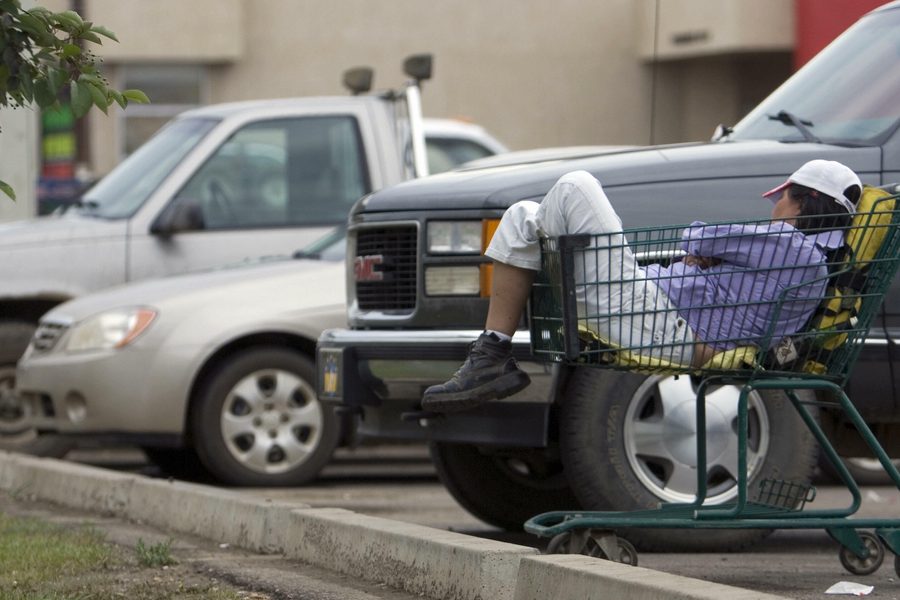
Alberta’s tar sands industry is often described as an environmental disaster, a catastrophe, even an apocalypse, tearing up millions of acres of boreal forest, sucking up rivers and contaminating wetlands and headwaters with myriad toxic chemicals.
But as Canadian journalist Andrew Nikiforuk describes in his recent book Tar Sands: Dirty Oil and the Future of a Continent, the industry that provides a seemingly limitless number of high-paying jobs is nonetheless a social and economic catastrophe for workers from Canada’s poorest areas, and those around the globe who are drawn to the boom-town promises of bitumen wealth.
Tar sands jobs typically pay $100,000 for workers with only a high-school degree, and draw adventure-seekers with an average age of 31 — much like the gold rushes or oil booms in the United States of decades or centuries past.
But even if these wages allow many to buy expensive cars and trucks, the industry usually puts workers and their families through hell, leaving them physically or emotionally broken and addicted.
And tar sand extraction can tear apart the social fabrics of once-sleepy towns and First Nations indigenous communities in Fort McMurray — otherwise known as Fort McMoney — and the surrounding areas in northern Alberta.
Exploiting the tar sands, also known as oil sands, involves heavy machinery, complicated technology and copious amounts of water to essentially suck a very heavy, dirty oily slurry out of thick sands, necessitating the removal of forest and wetlands and the creation of much toxic waste in the process.
Itinerant workers sleep in camp housing that is usually extremely crowded, unsanitary and violent. Cocaine and methamphetamine use is the norm, with one worker reporting his employer actually offered him $50,000 a month to peddle drugs to co-workers.
The drug abuse and general social mayhem have helped make Alberta’s spousal abuse rates the highest in the country and have overloaded hospitals and substance-abuse treatment centers.
Meanwhile, there is a severe shortage of doctors and nurses, an average 4,500-to-one physician-resident ratio, whereas the World Health Organization recommends 600:1. Doctors and nurses typically flee when confronted with the lack of resources and facilities and the constant abuse by drug-addled patients. One doctor described 14 days on 24-hour duty because there was no one to relieve her.
As a side effect of the fast money, drugs and flow of people in search of work, homelessness, crime and violence are rampant both in the tar sands territory and in Calgary, where Nikiforuk has seen his own hometown of 20 years become nearly unrecognizable.
Even with such high wages, 30 percent of the tar sands population live below the poverty line, because inflation has driven the cost of a home to $600,000 or more and even a trailer can cost $300,000.
Workplace injuries and even death are common. In 2007, there were 154 people killed on the job and 34,000 injured, according to Nikiforuk. Investigations proceed at a glacial pace and the many foreign workers – from China, Venezuela, Mexico, Croatia and other developing countries – are even more likely to be left without recourse if injured on the job.
High rates of suicide and self-injury and the grisly toll of auto accidents on the infamous Highway 63 leading to the tar sands are other morbid results of the industry, Nikiforuk writes.
Along with the foreign engineers and laborers, there is a high population of Filipino nannies and workers (men and women) from Canada’s poorest eastern provinces, including the “failed fishing communities of Newfoundland.”
A cut-throat social order emerges among workers, with laborers from the “depleted oil fields of China” shunned “because they behave and work like railway coolies,” in one worker’s words. “Construction workers are at the bottom of the heap,” and everyone “is paranoid and angry about something.”
Ten and 12-hour shifts for weeks on end with no day off are common. And since most have no intention of putting down roots in Alberta, but rather want to make their money and get out, there is very little effort put into building community or solidarity (though some sectors are unionized by the IBEW and other unions.)
Nikiforuk’s book, which won the Society of Environmental Journalists’ best book award this summer, certainly paints a terrifying picture of the environmental and human cost of the tar sands industry.
But it is also a chilling parable about the impact of greed run amok, and a cautionary note that in this time of economic crisis, job creation shouldn’t be celebrated without looking at the whole picture.
Kari Lydersen is a Chicago-based journalist, author and assistant professor at Northwestern University, where she leads the investigative specialization at the Medill School of Journalism, Media, Integrated Marketing Communications. Her books include Mayor 1%: Rahm Emanuel and the Rise of Chicago’s 99%.








